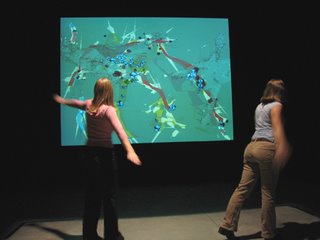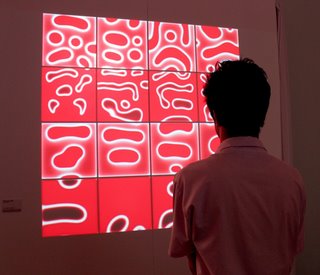Boston Cyberarts Festival
Here’s my preview of the 2007 Boston Cyberarts Festival, in which I argue that new media art is “the most distinctive sector of Boston-area [visual] art these days.”
I go on to say: “Boston's new media scene is simmering and scruffy, both thrilling and frustrating at this stage of development when few major artists have emerged.” Much of it seems to still be in an experimental testing phase – which can be cool, but often feels unripe.
Partly this reflects the basic nature of new media art, which often comes out of artists inventing new machines, new programs or new combinations and uses for existing technology. In other words, there’s a lot of stuff to puzzle out before you even get to what the art might be about.
 Still , too much of new media art is empty spectacle with a tech fetish, like San Francisco artist Camille Utterback’s installations at Art Interactive in Cambridge, in which cameras turn visitors' shuffling through the gallery into abstract doodles projected on the walls. (Pictured above: Utterback’s “Untitled 6,” 2005.) It’s a demonstration of the basic technology, rather than something that uses the machine to make something new.
Still , too much of new media art is empty spectacle with a tech fetish, like San Francisco artist Camille Utterback’s installations at Art Interactive in Cambridge, in which cameras turn visitors' shuffling through the gallery into abstract doodles projected on the walls. (Pictured above: Utterback’s “Untitled 6,” 2005.) It’s a demonstration of the basic technology, rather than something that uses the machine to make something new.
And lot of local new media art or tech art or cyberart (all lousy labels) is really old stuff in new packages. Photoshop special effects are basically the same gimmick as double-exposure “ghost” photos from the mid 19th century. Much video art rehashes experimental films made before the end of World War II with the primary differences being that the format is digital and the cuts are sometimes smoother. Compelling work can come out of this, but it’s not particularly engaged with or a result of the newness of the media.
 To me what’s most exciting is the work being made by folks who take advantage of the specific properties of the new media to embody their content. Like Bostonian Brian Knep’s computer projections, which use the machine’s knack for producing special effects and endless variations within set parameters to create distinctly digital art about natural systems, healing and aging. (Above: Knep’s “Drift Wall 2007.”)
To me what’s most exciting is the work being made by folks who take advantage of the specific properties of the new media to embody their content. Like Bostonian Brian Knep’s computer projections, which use the machine’s knack for producing special effects and endless variations within set parameters to create distinctly digital art about natural systems, healing and aging. (Above: Knep’s “Drift Wall 2007.”)
Or the recent “Personal Computer” show at Second Gallery, in which artists from New York and Georgia dissected familiar Web landmarks and then collaged the bits together into new abstract Web art to begin to consider how we interact with the Net and its mental-techno landscape.
Or New Yorker Ethan Ham’s “Self-Portrait” at BU’s Photographic Resource Center last fall, which deployed facial-recognition software to search for his likeness among the millions of photos posted to Flickr.com. So much art about the Internet is about how vast and lonely and bewildering it is. But Ham used computer data crunching to try to make sense of the Web and find connections.
As the number of out of town artists in these last two examples hint at, in some ways our wealth of local new media exhibition infrastructure – Cyberarts Festival, Axiom gallery, Art Interactive, Second Gallery, Gasp, MIT’s List Visual Art Center, etc., plus the local new media magazine Aspect – has outpaced the amount of accomplished new media art being produced here. This means we get to see lots of new media imports. But this – I guess you might call it – excess capacity seems also to be an optimistic bet on what local artists will create in the future and an effort to incubate it.
Boston Cyberarts Festival, various locations around greater Boston, April 20 to May 6, 2007. Click here for full schedule.
I go on to say: “Boston's new media scene is simmering and scruffy, both thrilling and frustrating at this stage of development when few major artists have emerged.” Much of it seems to still be in an experimental testing phase – which can be cool, but often feels unripe.
Partly this reflects the basic nature of new media art, which often comes out of artists inventing new machines, new programs or new combinations and uses for existing technology. In other words, there’s a lot of stuff to puzzle out before you even get to what the art might be about.
 Still , too much of new media art is empty spectacle with a tech fetish, like San Francisco artist Camille Utterback’s installations at Art Interactive in Cambridge, in which cameras turn visitors' shuffling through the gallery into abstract doodles projected on the walls. (Pictured above: Utterback’s “Untitled 6,” 2005.) It’s a demonstration of the basic technology, rather than something that uses the machine to make something new.
Still , too much of new media art is empty spectacle with a tech fetish, like San Francisco artist Camille Utterback’s installations at Art Interactive in Cambridge, in which cameras turn visitors' shuffling through the gallery into abstract doodles projected on the walls. (Pictured above: Utterback’s “Untitled 6,” 2005.) It’s a demonstration of the basic technology, rather than something that uses the machine to make something new.And lot of local new media art or tech art or cyberart (all lousy labels) is really old stuff in new packages. Photoshop special effects are basically the same gimmick as double-exposure “ghost” photos from the mid 19th century. Much video art rehashes experimental films made before the end of World War II with the primary differences being that the format is digital and the cuts are sometimes smoother. Compelling work can come out of this, but it’s not particularly engaged with or a result of the newness of the media.
 To me what’s most exciting is the work being made by folks who take advantage of the specific properties of the new media to embody their content. Like Bostonian Brian Knep’s computer projections, which use the machine’s knack for producing special effects and endless variations within set parameters to create distinctly digital art about natural systems, healing and aging. (Above: Knep’s “Drift Wall 2007.”)
To me what’s most exciting is the work being made by folks who take advantage of the specific properties of the new media to embody their content. Like Bostonian Brian Knep’s computer projections, which use the machine’s knack for producing special effects and endless variations within set parameters to create distinctly digital art about natural systems, healing and aging. (Above: Knep’s “Drift Wall 2007.”)Or the recent “Personal Computer” show at Second Gallery, in which artists from New York and Georgia dissected familiar Web landmarks and then collaged the bits together into new abstract Web art to begin to consider how we interact with the Net and its mental-techno landscape.
Or New Yorker Ethan Ham’s “Self-Portrait” at BU’s Photographic Resource Center last fall, which deployed facial-recognition software to search for his likeness among the millions of photos posted to Flickr.com. So much art about the Internet is about how vast and lonely and bewildering it is. But Ham used computer data crunching to try to make sense of the Web and find connections.
As the number of out of town artists in these last two examples hint at, in some ways our wealth of local new media exhibition infrastructure – Cyberarts Festival, Axiom gallery, Art Interactive, Second Gallery, Gasp, MIT’s List Visual Art Center, etc., plus the local new media magazine Aspect – has outpaced the amount of accomplished new media art being produced here. This means we get to see lots of new media imports. But this – I guess you might call it – excess capacity seems also to be an optimistic bet on what local artists will create in the future and an effort to incubate it.
Boston Cyberarts Festival, various locations around greater Boston, April 20 to May 6, 2007. Click here for full schedule.






0 Comments:
Post a Comment
<< Home